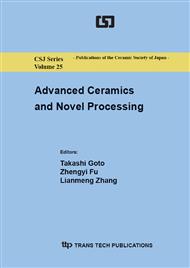[1]
R. Koc, J.S. Folmer, Synthesis of submicrometer titanium carbide powders, J. Am. Ceram. Soc. 80 (1997) 952-956.
DOI: 10.1111/j.1151-2916.1997.tb02926.x
Google Scholar
[2]
L.X. Cheng, Z.P. Xie, G.W. Liu, W.J. Xue, W. Liu, Densification and mechanical properties of TiC by SPS-effects of holding time, sintering temperature and pressure condition, J. Eur. Ceram. Soc. 32 (2012) 3399-3406.
DOI: 10.1016/j.jeurceramsoc.2012.04.017
Google Scholar
[3]
H. Endo, M. Uedi, H. Kubo, Hot pressing of SiC-TiC composites. J. Mater. Sci. 25 (1990) 2503-2506.
DOI: 10.1007/bf00638050
Google Scholar
[4]
J.Y. Ko, S.Y. Park, D.Y. Soon, S.J.L. Kang, Migration of intergranular liquid films and formation of core-shell grains in sintered TiC-Ni bonded to WC-Ni, J. Am. Ceram. Soc. 87 (2004) 2262-2267.
DOI: 10.1111/j.1151-2916.2004.tb07502.x
Google Scholar
[5]
D.I. Chun, D.Y. Kim, E.Y. Eun, Microstructure evolution during the sintering of TiC-Mo-Ni cermets, J. Am. Ceram. Soc. 76 (1993) 2049-2052.
DOI: 10.1111/j.1151-2916.1993.tb08331.x
Google Scholar
[6]
X.B. Zhang, N. Liu, Effects of ZrC on microstructure, mechanical properties and thermal shock resistance of TiC-ZrC-Co-Ni cermets, Mater. Sci. Eng. A 561 (2013) 270-276.
DOI: 10.1016/j.msea.2012.11.003
Google Scholar
[7]
X.B. Zhang, N. Liu, C.L. Rong, Microstructure and fracture toughness of TiC-ZrC-WC-Mo-Ni cermets, Inter. J. Refrac. Met. Hard Mater. 26 (2008) 346-356.
DOI: 10.1016/j.ijrmhm.2007.08.008
Google Scholar
[8]
W.T. Kwon, J. S. Park, S.W. Kim, S. Kang, Effect of WC and group IV carbides on the cutting performance of Ti(C,N) cermet tools. Inter. J. Mach. Tools. Manu. 44 (2004) 341-346.
DOI: 10.1016/j.ijmachtools.2003.10.023
Google Scholar
[9]
W.T. Kwon, J. S. Park, S. Kang, Effect of group IV elements on the cutting characteristics of Ti(C,N) cermet tools and reliability analysis. J. Mater. Proc. Tech. 166 (2005) 9-14.
DOI: 10.1016/j.jmatprotec.2004.06.009
Google Scholar
[10]
D.L. Yung, L. Kollo, I. Hussainova, A. Zikin, Reactive sintering of ZrC-TiC composites, Key Eng. Mater. 527 (2013) 20-25.
DOI: 10.4028/www.scientific.net/kem.527.20
Google Scholar
[11]
J.F. Shackelford, W. Alexander, CRC Materials Science and Engineering Handbook, third ed., CRC Press, London, 2000.
Google Scholar
[12]
G.R. Anstis, P. Chantikul, B.R. Lawn, D.B. Marshall, A critical evaluation of indentation techniques for measuring fracture toughness: I, direct crack measurements, J. Am. Ceram. Soc. 64(9) (1981) 533-538.
DOI: 10.1111/j.1151-2916.1981.tb10320.x
Google Scholar


